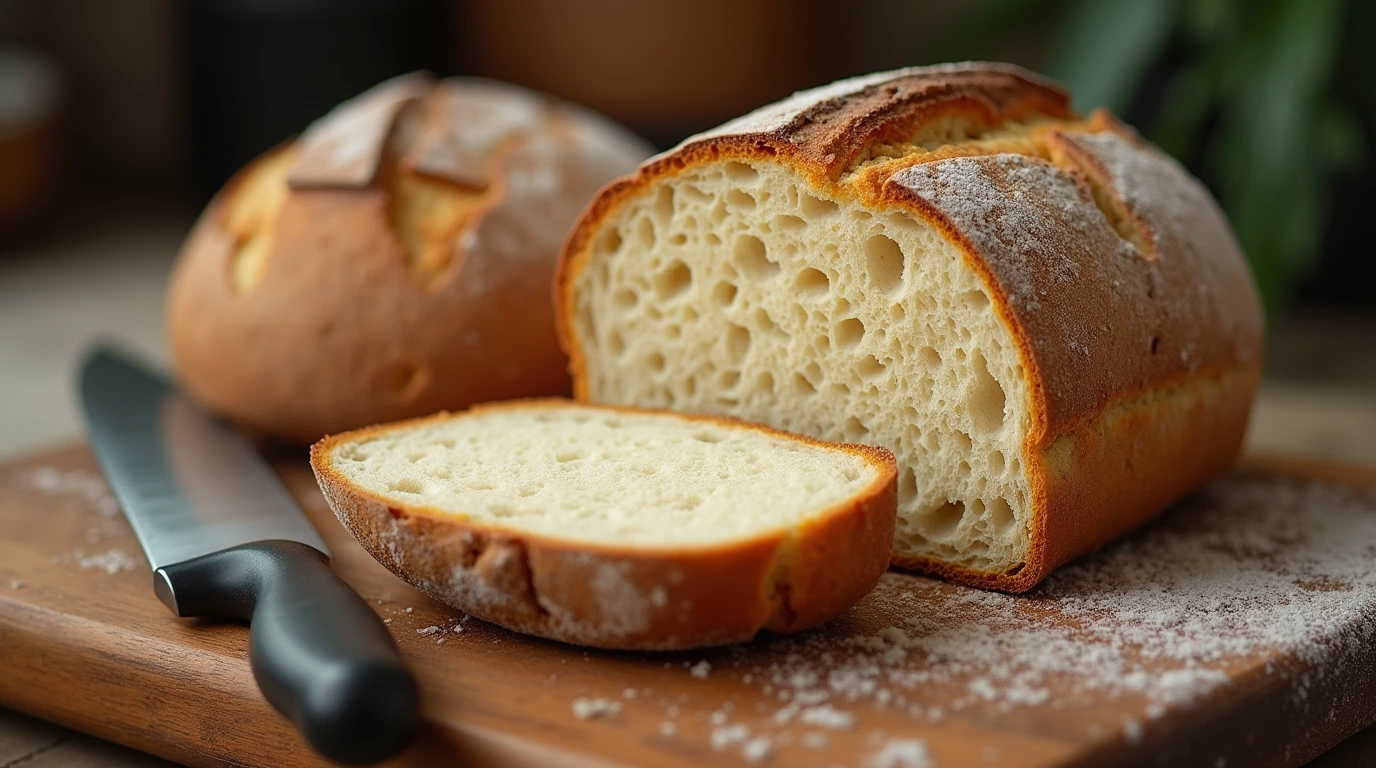Baking sourdough sandwich bread at home is now easier than ever. This guide will show you how to make delicious loaves in a loaf pan. You’ll learn about the ingredients, tools, and techniques for perfect sourdough bread. It’s great for sandwiches and toast.
- Key Takeaways
- Required Ingredients and Their Purpose
- Tools and Equipment You'll Need
- Choosing the Right Loaf Pan
- Initial Mix and Autolyse Process
- Proper Kneading Techniques
- Signs of Well-Developed Dough
- Optimal Oven Temperature and Steam
- Visual Cues for Doneness
- Cooling and Storage Methods
- What are the essential ingredients for baking sourdough sandwich bread?
- What type of loaf pan works best for baking sourdough sandwich bread?
- How do I maintain a healthy sourdough starter for sandwich bread baking?
- What are the key steps for properly mixing and developing the sourdough sandwich bread dough?
- How do I ensure the perfect proofing and shaping of my sourdough sandwich bread?
- What are the keys to achieving the perfect bake for my sourdough sandwich bread?
Key Takeaways
- Discover the key ingredients and necessary tools for baking sourdough sandwich bread in a loaf pan.
- Understand the importance of maintaining a healthy sourdough starter for consistent results.
- Learn the step-by-step process for mixing, kneading, and proofing the dough to achieve the ideal texture.
- Master the baking techniques, including managing oven temperature and steam, to ensure your loaves turn out perfectly golden brown.
- Explore cooling and storage methods to keep your sourdough sandwich bread fresh and flavorful.
Essential Ingredients and Equipment for Sourdough Sandwich Bread
To make delicious sourdough sandwich bread at home, you need a few key ingredients and the right tools. Knowing what each part does is key for the perfect taste and texture.
Required Ingredients and Their Purpose
The main ingredients for sourdough sandwich bread are:
- Flour – It’s the base, giving the bread its structure and texture.
- Water – It makes the dough wet, helping the gluten to grow.
- Salt – It adds flavor and helps control how the dough ferments.
- Active sourdough starter – It brings the natural yeast that makes sourdough special.
Tools and Equipment You’ll Need
For a smooth sourdough sandwich bread baking process, you’ll need these tools and equipment:
- Large mixing bowl for the dough
- Dough scraper or spatula for mixing and shaping
- Kitchen scale for accurately measuring ingredients
- Proofing basket or cloth-lined bowl for the first rise
- Loaf pan for shaping and baking the sourdough sandwich bread
Choosing the Right Loaf Pan
The loaf pan you choose can greatly affect your sourdough sandwich bread‘s shape and texture. Think about these factors when picking a pan:
| Loaf Pan Type | Ideal for | Benefits |
|---|---|---|
| Metal Loaf Pan | Sourdough loaf pan | Promotes even heat distribution and a crisp crust |
| Glass or Ceramic Loaf Pan | Soft sourdough sandwich bread | Retains moisture, resulting in a softer, more tender crumb |
By choosing the right ingredients, tools, and loaf pan, you’ll be ready to bake the perfect sourdough sandwich bread at home.
Understanding Your Sourdough Starter Maintenance
Keeping your sourdough starter healthy is key to baking great sourdough sandwich bread. Your starter is the heart of your bread. Taking good care of it can greatly improve your baking. Let’s look at the important parts of caring for your sourdough starter.
First, make a regular feeding schedule for your sourdough starter. It’s best to feed it once a day, or twice if you bake often. This keeps the yeast and bacteria active, making your bread rise well.
The best temperature for your sourdough starter is between 70°F and 80°F. If it’s too cold, fermentation slows down. If it’s too warm, the starter gets too active, leading to unpredictable results.
- Feed your sourdough starter with equal parts flour and water by weight.
- Discard some starter before adding fresh flour and water to keep it healthy.
- Watch for a mature starter, which is bubbly, active, and has a sour smell.
It’s important to check your sourdough starter often. Look at its consistency, activity, and smell. A healthy starter is lively and ready to make your bread dough into a tasty loaf of sourdough sandwich bread.
| Starter Maintenance Tip | Benefit |
|---|---|
| Consistent Feeding Schedule | Keeps the yeast and bacteria active and thriving |
| Optimal Temperature Range | Supports the fermentation process for reliable results |
| Observing Starter Health | Ensures the starter is ready to leaven your bread dough |
Learning to care for your sourdough starter will help you bake amazing sourdough sandwich bread. Enjoy the routine of caring for your starter. It will be the base for your tasty homemade bread.
Mixing and Developing the Perfect Sourdough Sandwich Bread Dough
Learning to mix and develop your sourdough sandwich bread dough is key. It makes your loaf soft and tender. Let’s explore the essential steps to get your dough ready for proofing and baking.
Initial Mix and Autolyse Process
Start by mixing your sourdough starter, water, and flour in a big bowl. Mix them gently until they form a shaggy dough. Then, let the dough rest for 30-60 minutes.
This autolyse step helps the flour hydrate. It makes the dough easier to knead and develop.
Proper Kneading Techniques
Once the autolyse is done, knead the dough. Use a gentle, yet firm, folding and stretching motion. This develops the gluten structure.
Don’t overdo it, as too much kneading can make the bread tough. Aim for 5-10 minutes of kneading. The dough should become smooth and elastic.
Signs of Well-Developed Dough
- The dough should pass the “windowpane” test, where you can gently stretch a small piece of dough until it’s thin and translucent without tearing.
- When you poke the dough, it should spring back slowly, indicating a well-developed gluten structure.
- The dough should feel smooth, supple, and slightly tacky to the touch, not dry or overly sticky.
By mastering these techniques for mixing and developing your sourdough sandwich loaf recipe, you’ll be well on your way to creating a soft sourdough sandwich bread. It’s perfect for all your sandwich-making needs.
Proofing and Shaping Your Sourdough Sandwich Bread
Learning to proof and shape your sourdough sandwich bread dough is key to a perfect loaf. This careful step makes sure your sourdough in loaf pan rises right. It gives you the classic taste and smell you love.
Start by letting your dough go through a bulk fermentation stage. This first proof lets the dough grow and get richer flavors. Look for signs like it getting a bit bigger and small bubbles on top to know it’s time to shape.
- Gently turn the dough out onto a lightly floured surface, being careful not to deflate it.
- Shape the dough into a tight, smooth loaf that will fit snugly into your prepared sourdough loaf pan.
- Place the shaped dough into the greased pan, seam-side down, and cover it with a damp towel or plastic wrap.
- Allow the dough to proof for an additional 1-2 hours, or until it has risen just above the rim of the pan.
Watching the dough rise and change during the final proof is important. The sourdough in loaf pan should grow but not too much. This prevents it from becoming dense and soggy. Keep an eye on it, ready to bake when it’s just right for a light, airy texture and a golden crust.

Mastering the Baking Process for Perfect Results
To get perfect sourdough sandwich bread, you need to master the baking process. Knowing the right oven temperature and the role of steam is key. It helps your loaf rise well and get a golden, crisp crust. Also, knowing when it’s done prevents over or under-baking, making your bread perfect every time.
Optimal Oven Temperature and Steam
Preheat your oven to 450°F (230°C) for the best results. To create steam, place a metal pan or cast-iron skillet on the bottom rack. Pour 1 cup of hot water into it before putting in your loaf. This steam helps the bread rise and get a crisp crust.
Visual Cues for Doneness
Watch your sourdough sandwich bread closely as it bakes. It’s done when it’s deep golden-brown and the inside is 205°F (96°C). The crust should be firm and crackly, and the loaf should sound hollow when tapped.
Cooling and Storage Methods
After baking, let your sourdough cool completely on a wire rack before slicing. Cooling helps set the crumb and keeps the bread from getting soggy. Store it in an airtight container or wrap it in a clean tea towel. This keeps it fresh for several days, with a soft interior and crisp crust.

FAQ
What are the essential ingredients for baking sourdough sandwich bread?
To make sourdough sandwich bread, you need flour, water, salt, and an active sourdough starter. Flour gives the bread its structure. Water makes the dough soft. Salt adds flavor. The sourdough starter gives the bread its tangy taste and helps it rise.
What type of loaf pan works best for baking sourdough sandwich bread?
A 9×5-inch loaf pan is best for sourdough sandwich bread. It helps the dough rise and bake evenly. This size pan also gives the bread a classic shape.
How do I maintain a healthy sourdough starter for sandwich bread baking?
Keep your sourdough starter healthy by feeding it flour and water regularly. The ideal temperature is 75-85°F. Look for signs like rapid expansion and bubbles to know it’s ready for baking.
What are the key steps for properly mixing and developing the sourdough sandwich bread dough?
First, mix the ingredients together. Then, let the flour hydrate during an autolyse period. Next, knead the dough to build its structure. Look for a smooth, elastic texture to know it’s ready.
How do I ensure the perfect proofing and shaping of my sourdough sandwich bread?
Watch the dough’s volume during proofing. It’s ready to shape when it jiggles slightly. Be gentle when shaping to keep the dough’s structure. Then, place it in the loaf pan for the final proof.
What are the keys to achieving the perfect bake for my sourdough sandwich bread?
For a perfect bake, use an oven at 450°F. Create steam to help the bread rise and get a crisp crust. Look for a deep golden brown color to know it’s done. Cool and store the bread properly to keep it fresh.
There are no reviews yet. Be the first one to write one.

